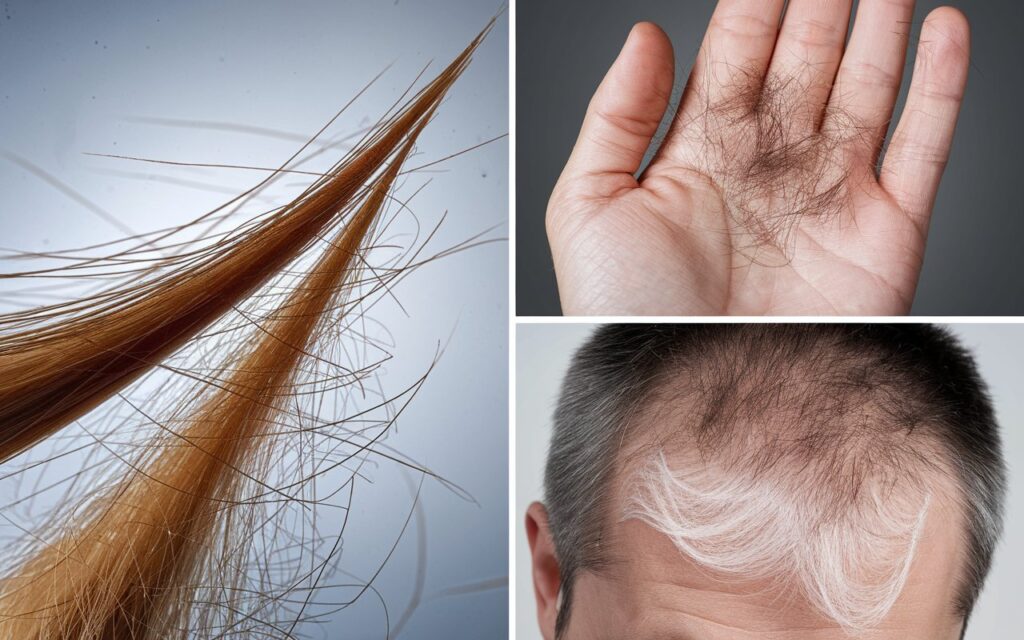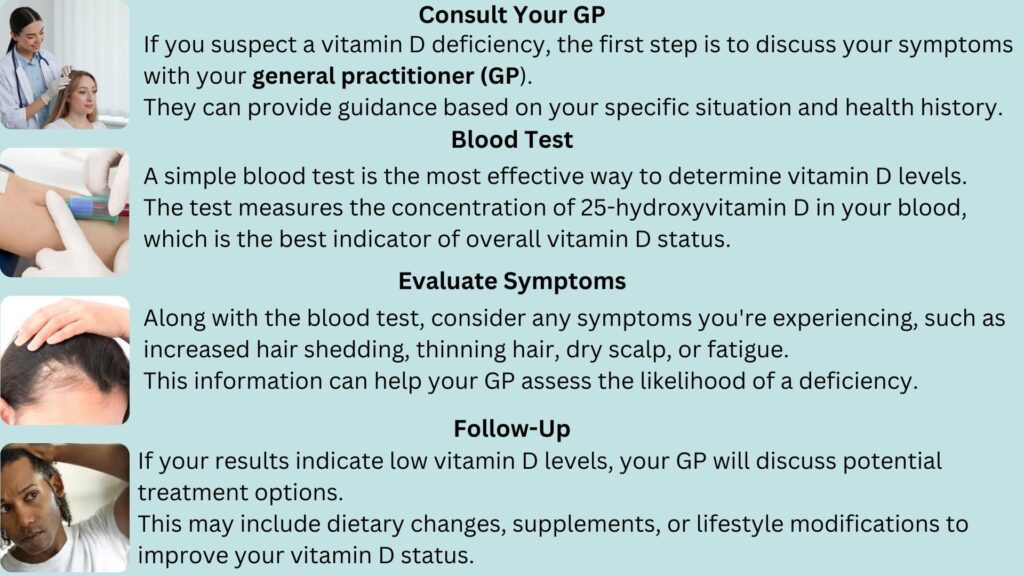Ever noticed your hair thinning and wondered, “Could it be my vitamin levels?”
You’re not alone.
Vitamin D deficiency and hair loss are real concerns that affect more people than you think. Vitamin D plays a crucial role in keeping your hair healthy. If your levels of this vital nutrient are low, it could be one of the reasons your hair is less thick and robust than it used to be.
Let’s break it down:
Vitamin D helps create new hair follicles—those tiny pores that allow hair to grow. Without enough vitamin D, your body can struggle to regenerate these follicles, leading to hair thinning or loss.
In short, Vitamin D deficiency and hair loss are both connected. Let’s dive into how this deficiency affects your hair and what you can do about it.
What’s the connection between having low Vitamin D levels in your body and losing hair?
Vitamin D is needed in the body to perform various functions and is also essential for hair follicles—the parts from which hair grows. A lack of vitamin D will disrupt hair growth and circular hair shedding, and one common disease that can result from a lack of vitamin D is the progressive loss of hair.
Vitamin D deficiency is linked to hair loss, while a sufficient amount encourages new hair follicle formations and general healthy hair follicle function. Therefore, vitamin D is essential to avoid hair loss and promote growth.
Why Does Vitamin D Deficiency Cause Hair Loss?

Here’s the simple truth: Vitamin D helps create new hair follicles. Hair follicles are those tiny little pores from which your hair grows. Without enough vitamin D, your body struggles to generate these follicles, leading to hair thinning or even hair loss.
Vitamin D plays a critical role in the hair growth cycle. It stimulates the hair follicles to grow and regenerate. When your vitamin D levels are low, this process slows down, and the follicles may become dormant. As a result, you see less hair growth and even hair shedding.
“Not enough vitamin D, not enough hair growth.”
It’s as straightforward as that.
Keep yourself informed about the latest research on Vitamin D deficiency and hair loss. Knowledge can empower you to make better choices.
Symptoms That Can Mean That You Have Vitamin D Deficiency And Hair Loss
1. Increased Hair Shedding
- You might run on low Vitamin D levels if you have more hair strands in your brush or shower.
- Keep track of how much hair you lose daily when combing, brushing, showering, or using hair products.
2. Thinning Hair
- Any drastic changes in volume may indicate that individual hair follicles are not in optimal working condition.
- Thinning might start gradually, so you must check to see if there is a problem.
3. Dry Scalp
- An itchy scalp is not taken very seriously but may point to typical vitamin deficiency.
- If not well handled, it causes discomfort and additional hair loss.
4. Fatigue
- Are you always feeling tired? A lack of enough Vitamin D can be associated with low energy levels.
- Most of the time, fatigue accompanies other symptoms and thus is the most unnoticed symptom.
If these signs are familiar, could you test yourself for vitamin D deficiency and hair loss levels? A blood test is all you need to clear the fuzzy image and tell you what to do next for your hair.
How to Diagnose Vitamin D Deficiency and Hair Loss

By taking these steps, you can effectively determine whether vitamin D deficiency and hair loss are linked in your case and take the appropriate action to address it.
Natural Sources of Vitamin D to Combat Hair Loss

1. Sunshine
- Aim for 15-30 minutes of sun exposure a few times a week.
- Your skin synthesises vitamin D when exposed to sunlight, making it one of the most effective sources.
2. Fortified Foods
- Fortified cereals, plant-based milk (like almond or soy milk), and orange juice are great sources of vitamin D.
- These foods are fortified with vitamin D and provide essential nutrients that improve hair health.
3. Eggs
- Don’t overlook eggs; they’re not just for breakfast!
- One egg yolk contains about 37 IU of vitamin D, making them a convenient source.
4. Mushrooms
- Opt for mushrooms exposed to UV light, such as maitake or shiitake.
- They can provide a plant-based source of vitamin D, especially for those following a vegetarian or vegan diet.
Incorporating these natural sources into your routine can significantly improve your vitamin D levels and reduce hair loss. If you have concerns about your intake or symptoms, please consult a healthcare professional.
While sunlight is essential for vitamin D deficiency and hair loss synthesis, it’s crucial to protect your skin from harmful UV rays. After spending a short period in the sun (about 15-30 minutes, depending on your skin type), apply a broad-spectrum sunscreen with at least SPF 30 to prevent skin damage and reduce the risk of sunburn.
How Much Vitamin D Do You Need for Healthy Hair?
Here’s a simple table outlining the recommended daily intake of Vitamin D based on age and other factors:
| Age Group | Recommended Daily Intake (IU) | Notes |
|---|---|---|
| Infants (0-12 months) | 400 IU | Important for bone and immune health |
| Children (1-18 years) | 600 IU | Supports growth and development |
| Adults (19-70 years) | 600 IU | Aids in calcium absorption |
| Adults (71+ years) | 800 IU | Higher needs due to decreased synthesis |
| Pregnant/Breastfeeding | 600-800 IU | Supports maternal and infant health |
Additional Considerations
- Deficiency Risks: Low Vitamin D levels can lead to hair loss or thinning.
- Sources: Sun exposure, fortified foods and supplements can help meet these needs.
Maintaining adequate Vitamin D levels can support overall hair health!
Doctors recommend about 600-800 IU of vitamin D daily for adults to support overall health, including hair growth. If you’ve been diagnosed with a vitamin D deficiency, your doctor might suggest a higher dose to get your levels back on track.
But here’s the key: Don’t guess. Get a blood test to check your vitamin D levels, so you know exactly where you stand. It’s the best way to ensure you get the right amount for healthy hair growth and overall well-being.
Incorporate foods fortified with Vitamin D, such as milk, orange juice, and cereals, into your diet to boost your intake.
Lifestyle Changes to Address Vitamin D Deficiency and Promote Hair Growth

Minor adjustments in your daily routine can produce excellent hair results and increase your Vitamin D level.
Here’s what you can do:
1. Get Outside More
- Light-skinned people have it especially easy in this aspect: going out in the sun helps increase your vitamin D levels significantly. Opt for sun exposure in 15-30 minute intervals several times weekly.
- I often practice walking at lunchtime or try to work in the garden during the weekends or when I have free time.
The healthiest position is to go out and perform some activities during the day without wearing sunscreen for some time and then get out of the sun later to avoid skin damage.
2. Eat a Balanced Diet
- A balanced diet can be beneficial for hair health. Focus on including a variety of nutrient-rich foods that support vitamin D intake and overall hair growth.
- Vegetarian options: Fortified cereals, plant-based milk (almond, soy), and fortified orange juice provide good sources of vitamin D.
- Leafy greens: Spinach and kale are rich in iron and folate, essential for hair strength.
- Nuts and seeds: Packed with healthy fats and vitamin E, they help promote healthy hair.
- Whole grains are important for overall well-being and help maintain proper nutrient absorption for your hair.
- Choose a rainbow of fruits and vegetables to ensure you get a variety of vitamins and minerals that support hair growth and overall health.
3. Stay Hydrated
- Water is crucial for your body and hair. Drink enough water throughout the day to ensure your body stays hydrated.
- Staying hydrated helps your body absorb nutrients more efficiently.
- Improved blood circulation also means better nutrient delivery to your hair follicles, promoting hair growth.
4. Exercise Routine
- Incorporating regular exercise into your routine can directly benefit your hair.
- Activities like walking, jogging, or yoga help increase blood flow to the scalp, ensuring that hair follicles receive the nutrients they need to grow strong and healthy.
- Exercise also supports your body’s ability to absorb and use vitamin D more effectively.
5. Manage Stress Levels
- Stress can be a significant factor in hair loss, so managing it is essential for your overall health and hair.
- Try diaphragmatic breathing, meditation, or mindful practices to reduce stress.
- Other stress-relief techniques, such as yoga, journaling, or time in nature, can help alleviate stress and improve hair health.
6. Prioritize Sleep
- Sleep is as essential as nutrition for hair health. Aim for 7-9 hours of good-quality Sleep every night.
- Proper Sleep helps balance hormones vital for hair growth and overall health.
- Lack of Sleep can hinder your body’s ability to function correctly, including producing and absorbing essential nutrients like vitamin D.
7. Limit Alcohol and Smoking
- Both alcohol consumption and smoking can negatively impact hair health.
- Reducing alcohol intake and quitting smoking will help improve blood flow and allow your body to absorb better the nutrients that promote hair growth.
- Smoking, in particular, restricts blood circulation to the scalp, making it harder for nutrients like vitamin D to reach your hair follicles.
These small, manageable changes can significantly improve your Vitamin D deficiency and hair loss, encouraging healthier, more robust hair growth. If you’re ever concerned about your vitamin D status or the health of your hair, don’t hesitate to consult a healthcare professional for tailored advice.
Hair regrowth takes time. Stay consistent with your efforts to address Vitamin D deficiency and hair loss, and be patient with the process.
Treatment Options for Vitamin D deficiency and hair loss
Exploring these treatment options can proactively address vitamin D deficiency and hair loss. It’s always a good idea to seek professional guidance for the best results tailored to your specific needs.
Maintaining a positive mindset can help reduce stress and promote overall well-being, supporting your hair health journey.
Conclusion
Vitamin D deficiency and hair loss are significant factors. Recognising the signs—such as increased shedding, thinning hair, and fatigue—is crucial for early intervention.
By incorporating natural sources of vitamin D, considering supplements, and making lifestyle changes, you can effectively boost your levels and promote healthier hair growth.
If you’re dealing with hair loss, it’s important to remember that various treatment options are available. From topical solutions like minoxidil to more permanent solutions like hair transplants, it’s crucial to seek professional advice to find the best solution.
Addressing vitamin D deficiency and hair loss is essential for hair health and overall well-being. Please consult a healthcare professional to make the best plan for you. Taking proactive steps today can lead to a healthier tomorrow!
FAQs
What is the connection between vitamin D deficiency and hair loss?
Vitamin D plays a crucial role in the hair growth cycle. Low levels can disrupt this cycle, leading to increased hair shedding and conditions like alopecia.
How can I tell if I have a vitamin D deficiency?
Common signs include increased hair shedding, thinning hair, dry scalp, fatigue, and mood changes. A blood test can confirm your vitamin D levels.
Should I take vitamin D supplements?
If dietary sources and sunlight exposure are insufficient, supplements can help boost your levels. Consult with a healthcare professional for appropriate dosage.
What treatments are available for vitamin D deficiency and hair loss ?
Treatment options include topical solutions like minoxidil, dietary changes, lifestyle modifications, and, in some cases, hair transplants.
How long does it take to see results from vitamin D supplementation for hair growth?
Results can vary, but many people may start noticing hair health improvements within a few months of consistent supplementation and lifestyle changes.
Can I get enough vitamin D from diet alone?
While some foods contain vitamin D, meeting daily requirements through diet alone can be challenging. Sun exposure is also essential for optimal levels.
Is it safe to use topical treatments while taking vitamin D supplements?
Yes, using topical treatments like minoxidil alongside vitamin D supplements is generally safe. However, consult your healthcare provider for personalised advice.

